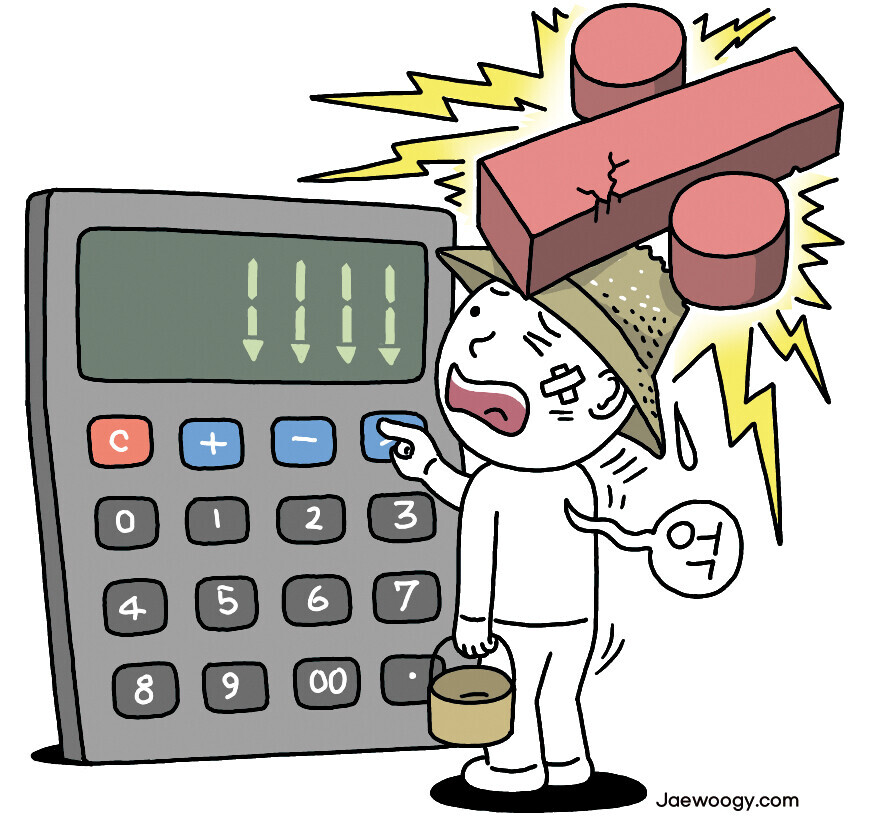hankyoreh
Links to other country sites 다른 나라 사이트 링크
[Column] How “overnight beggars” are made

In late March 2013, the public official ethics committee published statistics on the assets of members of South Korea’s National Assembly.
The assets of the 296 members were found to average no less than 9.49 billion won (US$8.27 million). It wasn’t that they were all millionaires. The average was boosted enormously by the massive fortunes of Saenuri Party lawmakers Chung Mong-joon (1.9249 trillion won, US$1.67 billion) and Ko Hee-sun (198.4 billion won, US$172.99 million).
When those two were ignored, the average for the remaining 294 lawmakers was less than a fourth as large at 2.33 billion won (US$2.03 million). Such are the pitfalls of using averages.
On July 22, the Bank of Korea (BOK) and Statistics Korea published a 2020 National Balance Sheet. The numbers showed average net assets averaging 510 million won (US$444,694) per household last year.
The figure was arrived at by dividing the 10.423 quadrillion won in total net assets for households and non-profit organizations by the estimated 20,350,000 households.
Housing prices were up by 11.9% from the year before. A purchasing power parity conversion gave a total of US$594,000, which was larger than Japan’s US$500,000.
Even if we ignore the non-profit organizations inflating the household average somewhat, this still means that net assets exceeded 500 million won (US$436,031) per household, up to and including single-person households.
Does this mean we’re all rich? Here, too, we see the pitfall of averages when we divide those assets up by income level.
A distribution of net assets by income level can be found in the Survey of Household Finance and Living Conditions, an examination of 20,000 sample households nationwide performed jointly by Statistics Korea with the Financial Supervisory Service and BOK.
As of late March 2020, net assets stood at 362,870,000 won (US$316,603) per household. The median for net assets — meaning the person at the very center if everyone were lined up according to amount — was just 202,180,000 won (US$176,401). The reason for the big gap between the average and the median is the small number of very wealthy people driving up the average.
Slightly fewer than one-third of all households (32.2%) have net assets of less than 100 million won (US$87,249). Nearly half (49.6%) have less than 200 million won (US$174,499), while 62.3% have less than 300 million won (US$261,749).
Such is the asset situation for ordinary South Korea. Only 7.2% of all households had net assets exceeding one billion won (US$ 872,756).
The percentage of all net assets represented by the top 10% (those with 833,720,000 won — US$727,634 — or more) has risen annually from 42.3% in 2018 to 43.3% in 2019 and 43.7% in 2020.
The rise in household assets has been propelled by a rise in residential housing prices. With the median price of an apartment in Seoul exceeding 900 million won (US$785,704), it’s a “riches to rags” story even for the person standing smack in the middle of all households in terms of assets.
By Jeong Nam-ku, editorial writer
Please direct comments or questions to [english@hani.co.kr]

Editorial・opinion
![[Column] Park Geun-hye déjà vu in Yoon Suk-yeol [Column] Park Geun-hye déjà vu in Yoon Suk-yeol](https://flexible.img.hani.co.kr/flexible/normal/500/300/imgdb/original/2024/0424/651713945113788.jpg) [Column] Park Geun-hye déjà vu in Yoon Suk-yeol
[Column] Park Geun-hye déjà vu in Yoon Suk-yeol![[Editorial] New weight of N. Korea’s nuclear threats makes dialogue all the more urgent [Editorial] New weight of N. Korea’s nuclear threats makes dialogue all the more urgent](https://flexible.img.hani.co.kr/flexible/normal/500/300/imgdb/original/2024/0424/7317139454662664.jpg) [Editorial] New weight of N. Korea’s nuclear threats makes dialogue all the more urgent
[Editorial] New weight of N. Korea’s nuclear threats makes dialogue all the more urgent- [Guest essay] The real reason Korea’s new right wants to dub Rhee a founding father
- [Column] ‘Choson’: Is it time we start referring to N. Korea in its own terms?
- [Editorial] Japan’s rewriting of history with Korea has gone too far
- [Column] The president’s questionable capacity for dialogue
- [Column] Are chaebol firms just pizza pies for families to divvy up as they please?
- [Column] Has Korea, too, crossed the Rubicon on China?
- [Correspondent’s column] In Japan’s alliance with US, echoes of its past alliances with UK
- [Editorial] Does Yoon think the Korean public is wrong?
Most viewed articles
- 1‘We must say no’: Seoul defense chief on Korean, USFK involvement in hypothetical Taiwan crisis
- 2N. Korean delegation’s trip to Iran shows how Pyongyang is leveraging ties with Moscow
- 3‘Weddingflation’ breaks the bank for Korean couples-to-be
- 4Will NewJeans end up collateral damage in internal feud at K-pop juggernaut Hybe?
- 546% of cases of violence against women in Korea perpetrated by intimate partner, study finds
- 6[Column] Park Geun-hye déjà vu in Yoon Suk-yeol
- 7“Parental care contracts” increasingly common in South Korea
- 8[Column] Yoon’s first 100 days should open our eyes to pitfalls of presidential system
- 9[Interview] Dear Korean men, It’s OK to admit you’re not always strong
- 10[Editorial] New weight of N. Korea’s nuclear threats makes dialogue all the more urgent